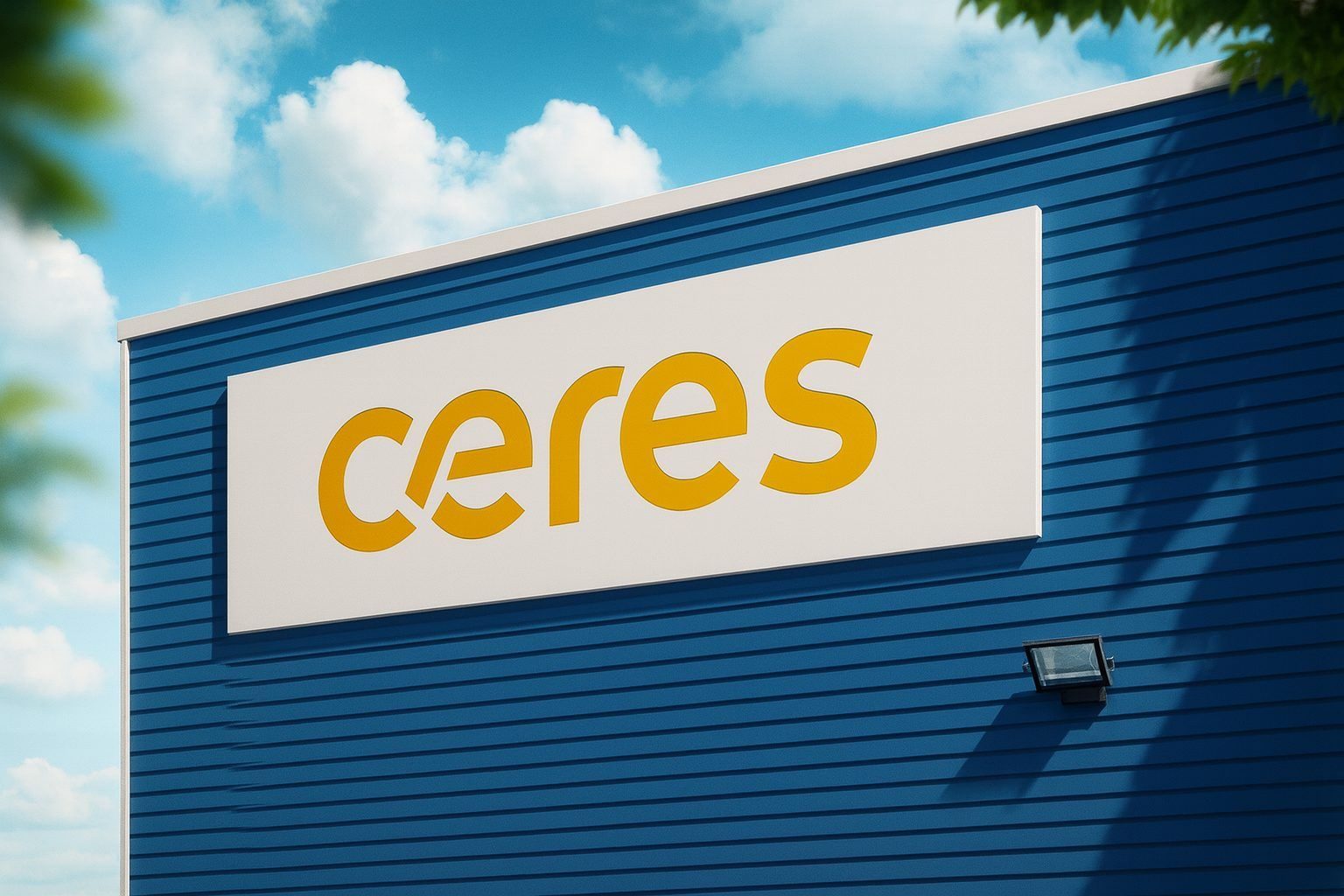27 November 2025 – London
Ceres Power Holdings plc (LSE: CWR), the UK solid‑oxide fuel cell and electrolysis specialist, traded higher on Thursday after a fresh bullish note from UBS highlighted accelerating manufacturing licences, growing data‑centre demand and a path to cash breakeven in 2026. [1]
Live data from London South East showed Ceres Power shares around 345–346p, up about 2.4% on the day, with an intraday range between roughly 339p and 355p. [2] Earlier opening‑bell coverage from Sharecast also had the company among the FTSE 250 risers, quoting the stock at 345.40p, up 2.31%. [3] At these levels, market data providers put Ceres’ market capitalisation in the mid‑£600m range. [4]
Today’s key Ceres Power headlines (27 November 2025)
- UBS reiterates “Buy” with 570p target
In a brief note summarised by Hydrogen Central and Proactive, UBS says it has become more optimistic on Ceres following a recent roadshow with CFO Stuart Paynter. The bank repeats a Buy rating and 570p price target, highlighting licence momentum, better access to the US market, partner‑driven cost reductions and stronger intellectual‑property protections in the latest Weichai agreement. [5] - CWR outperforms broader UK market after UK Budget
Sharecast’s “London open” report lists Ceres among the best FTSE 250 performers in early trade, while a UK market wrap on TS2.Tech later in the morning notes that Close Brothers and Ceres Power were also higher, as investors rotated into select mid‑cap cyclicals following Rachel Reeves’ tax‑raising Budget. [6] - Hydrogen fuel cell market research flags Ceres as a key player
A new industry report distributed via EINPresswire projects the global hydrogen fuel‑cell market will reach about $5.7bn by 2031, growing at roughly 8.1% CAGR, and names Ceres Power alongside Ballard, Bloom, Plug Power and Doosan as one of the leading companies in the space. [7]
Together, these headlines frame today’s move in CWR as part of a larger story: a still‑loss‑making technology company trying to convert a deep partnership pipeline into recurring licensing and royalty income.
UBS: one more licence could unlock 2026 breakeven
According to the UBS commentary, the bank’s increased conviction rests on four main pillars: [8]
- Faster licence signings – Management has consistently pointed to at least one additional manufacturing licence being in “late‑stage” negotiation, and UBS now appears more confident that this deal will land. [9]
- Clearer route into the US power market – Ceres’ partners are targeting the booming US market for data‑centre and distributed power, helped by favourable Investment Tax Credits for fuel cells under section 48E. [10]
- Partner‑led cost reductions – As partners move from pilot lines to mass production, UBS sees scope for material system cost cuts, boosting the economics of Ceres‑based solutions. [11]
- Strengthened IP safeguards in the Weichai deal – The new Weichai manufacturing licence includes updated intellectual‑property protections, which the broker views as critical for long‑term royalty streams in China. [12]
UBS also echoes Ceres management’s guidance that the group can hit EBITDA and cash breakeven in 2026 if it signs at least one more major manufacturing licence. [13] With the shares still trading at a substantial discount to the 570p target, the bank argues that successful execution could deliver upside of roughly two‑thirds from current levels.
That path, however, remains heavily contingent on closing new deals and seeing existing partners ramp production as planned.
Share price reaction: mid‑caps in focus after the Budget
Today’s move in Ceres Power is unfolding against a complicated macro backdrop. London’s main indices were little changed in Thursday’s open, with investors digesting a tax‑heavy Budget and quiet US trading due to Thanksgiving. [14]
- Sharecast’s opening snapshot showed the FTSE 250 up 0.42%, with Ceres Power among the notable risers. [15]
- TS2.Tech’s mid‑session wrap describes a “cheerful” day for some mid‑caps, citing Pennon Group, Playtech and Watches of Switzerland, and notes that Close Brothers and Ceres Power were also higher, suggesting a modest rotation into domestically exposed cyclicals and growth names. TechStock²
On London South East’s live page for CWR, Ceres’ share price was indicated at 345.6p, with a day’s high of 355.2p and low of 338.8p, up 8p (2.37%) versus Wednesday’s close of 337.6p. [16]
Why the Weichai manufacturing licence matters so much
UBS’s bullishness cannot be separated from Ceres’ key strategic news earlier this month: a manufacturing licence with Weichai Power in China, announced on 5 November. [17]
According to Ceres’ own release:
- Weichai will manufacture cells and stacks based on Ceres’ solid oxide fuel‑cell (SOFC) technology for its stationary power systems, targeting use cases such as AI data centres, commercial buildings and industrial power. [18]
- The deal supersedes previous agreements with Weichai and expands Ceres’ global manufacturing partner portfolio to four. [19]
- Ceres expects licence fees, milestone payments and royalties “consistent with previous manufacturing licensing agreements”, but the bulk of revenue recognition is likely to fall in FY26, so 2025 revenue guidance is unchanged. [20]
Market reaction to the Weichai announcement was dramatic: a Reuters piece carried on LSE’s news feed reported that Ceres Power shares surged over 23% on the day as investors priced in the China data‑centre opportunity. [21]
For UBS, the Weichai licence is a proof‑point that Ceres’ licensing model can attract large, well‑capitalised partners willing to invest in local manufacturing in exchange for access to its IP.
Commercial ramp: Doosan, Delta, Thermax and Shell
Weichai is not the only partner moving from pilots to hardware.
Doosan Fuel Cell: first mass‑production partner
In July, Ceres and South Korea’s Doosan Fuel Cell announced the start of mass‑market production of fuel‑cell stacks and power systems using Ceres’ SOFC technology: [22]
- The dedicated factory in Jeollabuk‑do can produce fuel‑cell stacks and systems equivalent to around 50MW of electrical capacity per year.
- Doosan becomes the first strategic licensee to reach full‑scale manufacturing of Ceres’ metal‑supported SOFC design.
- Initial markets include stationary distributed power for data centres, power‑grid stabilisation, commercial buildings and marine auxiliary power.
Ceres CEO Phil Caldwell called Doosan’s start of mass manufacturing “a major step in bringing this technology to the world,” emphasising the role of fuel cells in meeting power‑hungry AI workloads while supporting decarbonisation. [23]
Delta, DENSO, Thermax and Shell: building the ecosystem
Ceres’ Interim Results presentation for H1 2025 sketched out a broader ecosystem: [24]
- Delta Electronics (Taiwan) has acquired land and factory facilities, committing around £170m to large‑scale manufacturing of hydrogen energy solutions as Ceres’ first dual SOFC/SOEC stack manufacturing licensee. [25]
- DENSO and JERA are running a demonstration of Ceres‑based SOEC hydrogen production, showcasing the reversible nature of the technology. [26]
- Shell and Ceres have a 1MW electrolysis demonstrator in India, already producing hydrogen at around 37 kWh per kilogram, illustrating the company’s push into industrial green hydrogen. [27]
- In India, Thermax has partnered with Ceres to develop large‑scale SOEC systems that use industrial waste heat for green hydrogen production, with plans for local manufacturing aimed at heavy‑industry customers such as steel and refineries. [28]
This web of agreements underpins UBS’s thesis that Ceres can generate meaningful recurring royalties once multiple partners reach multi‑gigawatt scale.
Financial snapshot: slower revenue, strong margins, transformation under way
The bullish broker note comes just weeks after Ceres’ half‑year 2025 results, published on 26 September. [29]
Key numbers for the six months to 30 June 2025:
- Revenue: £21.1m, down 26% year‑on‑year from £28.5m.
- Gross margin: 79% (vs 80% a year earlier), reflecting the high‑margin licensing model despite lower volumes.
- Gross profit: £16.6m, down 27%.
- Adjusted EBITDA: loss of £11.3m, widening from a £9.0m loss in H1 2024.
- Order intake: just £0.9m, compared with £46.9m in the prior‑year period, reflecting the absence of new licence signings in the half.
- Cash & short‑term investments:£104.1m, up slightly from £102.5m at December 2024, thanks to a £1.6m cash inflow in the half. [30]
Management describes 2025 as a “landmark year” in which Ceres is transitioning from R&D to commercial deployment. A business transformation programme is under way to realign resources with near‑term power‑market opportunities, targeting: [31]
- A ~20% reduction in operating expenses by 2026 versus 2025.
- Support for partners’ manufacturing ramp‑ups.
- A clearer focus on data‑centre and industrial power applications as “killer apps” for SOFC power.
Full‑year 2025 revenue is guided to around £32m, with any new manufacturing licence providing upside if signed in time to be recognised this year. [32]
Analyst consensus and valuation context
UBS is not alone in its positive stance, though its 570p target sits at the top end of the range.
- Data compiled by Investing.com suggests that, across eight analysts, the average 12‑month price target for Ceres is about 371p, with a high estimate of 570p and a low of 115p; the overall rating screens as “Buy”. [33]
- MarketBeat, which tracks a smaller analyst sample, shows an average target closer to 495p, with a high of 530p, also indicating a broadly positive stance. [34]
In other words, while opinions vary, the Street generally sees upside from today’s mid‑300s share price, but assumes that Ceres can execute on its licence pipeline and partners’ scale‑up plans.
Strategic backdrop: hydrogen, fuel cells and the FTSE 250
Ceres’ story is playing out against robust long‑term growth forecasts for both green hydrogen and fuel cells:
- Precedence Research estimates the green hydrogen market could reach about $413bn by 2035, driven by decarbonisation in refining, ammonia, steel and transport. [35]
- Allied Market Research, via EINPresswire, expects the hydrogen fuel‑cell market to hit $5.7bn by 2031, highlighting Ceres Power as one of the leading global players investing in product innovation, partnerships and international expansion. [36]
Index changes have also raised the company’s profile. FTSE Russell announced that Ceres Power would join the FTSE 250 Index, moving up from the FTSE SmallCap with effect from 30 October 2025. [37] Inclusion in the mid‑cap benchmark tends to broaden the shareholder base as more index and ETF investors gain exposure.
Risks and what to watch next
Despite today’s upbeat tone, Ceres Power remains a high‑risk, high‑reward proposition:
- Deal‑execution risk: The 2026 breakeven story depends on signing at least one more major licence. Any delay or failure here would undermine the UBS thesis. [38]
- Ramp‑up and technology risk: Partners such as Weichai and Doosan must successfully scale manufacturing and deliver reliable systems at competitive costs; setbacks could slow royalty growth or dent the brand. [39]
- Demand and policy risk: While AI data centres and industrial decarbonisation are powerful drivers, project timelines and regulatory frameworks can shift, affecting the pace of adoption. [40]
- Financial risk: Ceres is still loss‑making, and although cash levels are currently comfortable, extended delays in licence revenue could force difficult choices on investment and cost‑cutting. [41]
Key catalysts to watch over the coming months include:
- Announcement of any new manufacturing licence, especially one addressing the US market.
- Further detail on Weichai’s factory build‑out and initial orders for data‑centre power systems. [42]
- Evidence of commercial deployments from Doosan, Delta and Thermax, particularly for AI data‑centre and industrial hydrogen projects. [43]
- The 2025 full‑year results, which will show whether the business transformation plan is delivering the promised cost savings and cash‑flow trajectory. [44]
Bottom line
Today’s UBS commentary and the resulting share‑price strength underline that institutional investors still see Ceres Power as one of the more credible pure‑play solid oxide technology platforms listed in London. The upside case is clear: if multiple partners ramp successfully and another licence lands, Ceres could shift from upfront development revenue to a growing stream of high‑margin royalties within a few years.
But the company is still in the delicate transition from R&D to scaled commerce, and much of the valuation depends on deals that are not yet signed or factories that have only just begun to produce.
For now, Ceres remains a stock for investors comfortable with technology, execution and policy risk – and Thursday’s trading session simply shows that the market is willing, at least for today, to give the story the benefit of the doubt.
Disclaimer: This article is for information and general news purposes only and does not constitute investment advice or a recommendation to buy or sell any security. Always do your own research or consult a regulated financial adviser before making investment decisions.
References
1. hydrogen-central.com, 2. www.lse.co.uk, 3. www.sharecast.com, 4. www.advfn.com, 5. hydrogen-central.com, 6. www.sharecast.com, 7. www.einpresswire.com, 8. hydrogen-central.com, 9. www.ceres.tech, 10. www.ceres.tech, 11. www.ceres.tech, 12. www.ceres.tech, 13. hydrogen-central.com, 14. www.sharecast.com, 15. www.sharecast.com, 16. www.lse.co.uk, 17. www.ceres.tech, 18. www.ceres.tech, 19. www.ceres.tech, 20. www.ceres.tech, 21. www.lse.co.uk, 22. www.ceres.tech, 23. www.ceres.tech, 24. www.ceres.tech, 25. www.ceres.tech, 26. www.ceres.tech, 27. www.ceres.tech, 28. www.globenewswire.com, 29. www.ceres.tech, 30. www.ceres.tech, 31. www.ceres.tech, 32. www.ceres.tech, 33. www.investing.com, 34. www.marketbeat.com, 35. www.globenewswire.com, 36. www.einpresswire.com, 37. www.investegate.co.uk, 38. hydrogen-central.com, 39. www.ceres.tech, 40. www.ceres.tech, 41. www.ceres.tech, 42. www.ceres.tech, 43. www.ceres.tech, 44. www.ceres.tech










